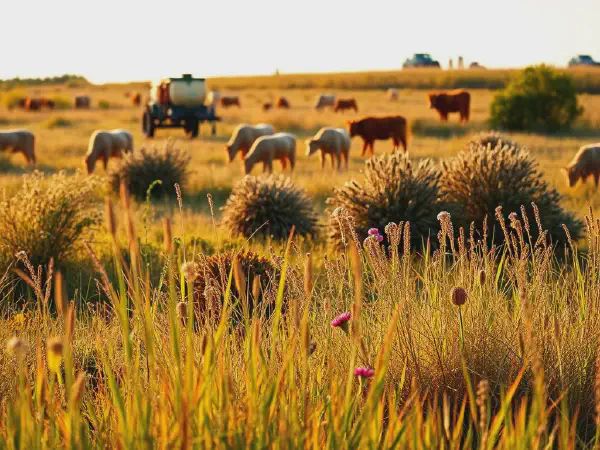Top Brush Killer Options: Effective Solutions for Landowners

Discovering the Best Brush Killer for Your Needs
When it comes to maintaining a beautiful landscape or agricultural area, finding the Best Brush Killer is essential. Brush killers are specialized herbicides designed to eliminate unwanted woody plants and shrubs, which can compete with desirable plants for nutrients, water, and sunlight. The right brush killer not only helps to clear out invasive species but also promotes healthy growth of your preferred flora.
Selecting the Best Brush Killer can be a challenging task due to the wide variety of products available on the market. To make a well-informed choice, it’s important to consider factors such as the types of brush present, the application method, and the potential impact on surrounding vegetation. In this article, we delve into what makes a brush killer effective, the different types available, and how to use them safely and efficiently.
Whether you are dealing with stubborn brush in your backyard or large-scale agricultural land, understanding the properties of the Best Brush Killer will aid in getting the results you desire. This guide will help you navigate through the various types of brush killers, the best application methods, safety precautions, and strategies for long-term success in brush management.
In addition, knowing the timing of application and post-treatment care is crucial for achieving the best results. The right brush killer, combined with proper usage techniques and timing, can significantly enhance the effectiveness of your landscape management efforts. Read on to uncover all you need to know about the Best Brush Killer to make your eradication efforts successful.
From understanding the types of brush killers to learning about application methods and safety protocols, this article will equip you with the knowledge to choose and use the Best Brush Killer for your specific needs.
Types of Brush Killers
Brush killers can be categorized into herbicide and non-herbicide options. Herbicides are chemical solutions designed to kill unwanted vegetation, while non-herbicide alternatives may include manual removal or organic solutions that deter regrowth. The choice between the two will depend on the user’s environmental considerations and the extent of the brush problem.
For effective land management, discovering the Best Brush Killer can significantly enhance your results.
Brush killers are also classified based on their action as systemic or contact solutions. Systemic brush killers are absorbed by the plant and spread throughout, targeting the roots and stems for complete destruction, while contact killers destroy only the parts of the plant they directly touch, making them less effective for deep-rooted species.
Moreover, brush killers come in natural and synthetic formulations. Natural brush killers are derived from plant-based substances and are often considered more environmentally friendly. In contrast, synthetic ones are man-made chemicals designed to be potent against stubborn brush, usually offering faster results but often raising ecological concerns.
Application Methods
Effective application methods for brush killers are essential for achieving optimal results. Spraying techniques are among the most common methods; they typically involve using a sprayer to distribute the brush killer evenly over the foliage. For best results, it’s important to choose the right nozzle and maintain the proper distance to avoid overspray.
Soil application methods are another way to utilize brush killers, especially for systemic types. This method involves applying the herbicide directly to the soil where the brush roots can absorb it. It is particularly effective for preventing regrowth of established plants, but care must be taken to prevent affecting desired species in the surrounding area.
Using granular brush killers is another effective method. These products can be spread over the target area like fertilizer. Granular formulations are often a preferred choice for large areas as they are easier to apply and can be effective when watered into the soil, allowing the active ingredients to penetrate the root zone.
Safety Precautions
When handling brush killers, it's crucial to wear protective gear, including gloves, goggles, and masks, to prevent exposure to chemicals. Following safety precautions and manufacturer guidelines will help reduce health risks during application.
Moreover, considering environmental safety is paramount. Users should be aware of how their chosen brush killer may impact beneficial insects, wildlife, and surrounding vegetation. It’s essential to read labels and choose products that minimize ecological disruption.
In the event of herbicide exposure, knowing basic first aid protocols can be life-saving. Always keep emergency contacts accessible, and if exposure occurs, follow the manufacturer's instructions for decontamination and seek medical assistance if necessary.
Effectiveness and Timing
To maximize the effectiveness of brush killers, timing is crucial. The best times to apply brush killers are usually during the growing season when the plants are actively taking up nutrients and water. Early spring or late fall, before the first frost, are often ideal for systemic applications as the plant is more likely to absorb the herbicide effectively.
Several factors can affect the effectiveness of brush killers, including weather conditions, the stage of growth of the brush, and application technique. For example, applying during dry or windy conditions may lead to reduced absorption and wastage through drift.
Users should also consider the difference between long-term and short-term solutions. Some brush killers are designed for immediate eradication, while others provide lasting prevention against re-establishment. Understanding your specific needs will guide your choice in this regard.
Post-application Care
After application of brush killers, managing vegetation is important to prevent unwanted growth. It may involve monitoring treated areas and removing any surviving weeds or brush promptly.
Preventing re-growth of brush requires not just the right application but also continuous landscape management practices, including mulching or planting desirable ground cover to suppress weed growth with healthy vegetation.
Finally, monitoring and follow-up treatments are critical for achieving long-lasting results. Regular inspections of the treated area will help identify any new growth early, allowing for prompt action and additional applications to maintain the effectiveness of your brush killer. Through proper use, the Best Brush Killer can transform your landscape effectively and sustainably.
